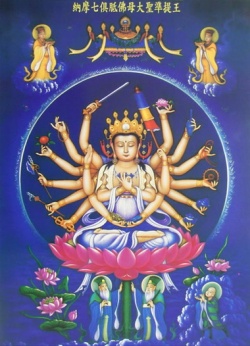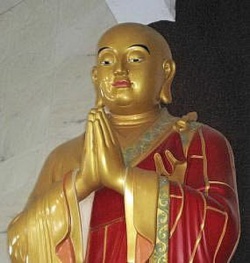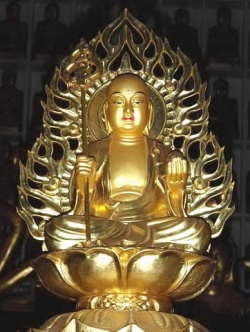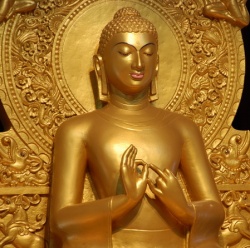Avatamsaka Sutra
- See also :
- See also :
Avatamsaka Sutra (Skt. Avataṃsakasūtra; Tib. ཕལ་པོ་ཆེ་, Wyl. mdo phal po che) — one of the most important (and largest) of all Mahayana sutras.
It includes the Sutra of the Ten Bhumis and the Gandavyuha Sutra, which in turn includes Samantabhadra's Aspiration to Good Actions.
The Tibetan version in 45 chapters was translated in the 9th century by Surendra and Vairocana Rakṣita. It's a voluminous sutra comprising four volumes in the Kangyur (Derge edition).
Avatamsaka Sutra (Fo-tuo Ga-ye) was taught to Bodhisattvas and Buddhas and other higher beings at Bodhgaya directly after the Buddha’s enlightenment. This was the principle text of the Hua-yen school.
Quotation
ང་ཉིད་ཡི་གེའི་གཟུགས་སུ་གནས། །
ང་ཡིན་སྙམ་དུ་ཡིད་བྱོས་ལ། །
In the last five hundred year period,
I will appear in the form of scriptures.
Consider them as identical to me,
And treat them with due respect.
Translations
- The Flower Ornament Scripture, translated (from Chinese) by Thomas Cleary (Boston & London: Shambhala, 1987, 1993)
See Also
External Links
 འཕགས་པ་སངས་རྒྱས་ཕལ་པོ་ཆེ་ཞེས་བྱ་བ་ཤིན་ཏུ་རྒྱས་པ་ཆེན་པོའི་མདོ།, Derge Kangyur, Volumes 35,36, 37 & 38
འཕགས་པ་སངས་རྒྱས་ཕལ་པོ་ཆེ་ཞེས་བྱ་བ་ཤིན་ཏུ་རྒྱས་པ་ཆེན་པོའི་མདོ།, Derge Kangyur, Volumes 35,36, 37 & 38 The Sūtra of the Ornament of the Buddhas
The Sūtra of the Ornament of the Buddhas
Source
A sutra belonging to the third turning of the Wheel of Dharma. Published as Flower Adornment Sutra, Shambhala Publications.
Source
The Avataṃsaka Sūtra (Sanskrit: महावैपुल्यबुद्धावतंसकसूत्र Mahāvaipulya Buddhāvataṃsaka Sūtra) is one of the most influential Mahayana sutras of East Asian Buddhism. The title is rendered in English as Flower Garland Sutra, Flower Adornment Sutra, or Flower Ornament Scripture.
The Avataṃsaka Sūtra describes a cosmos of infinite realms upon realms, mutually containing one another. The vision expressed in this work was the foundation for the creation of the Huayan school of Chinese Buddhism, which was characterized by a philosophy of interpenetration. Huayan is known as Kegon in Japan.
Title
This work has been used in a variety of countries. Some major traditional titles include the following:
- Sanskrit: Mahāvaipulya Buddhāvataṃsaka Sūtra ( महावैपुल्यबुद्धावतंसकसूत्र). "The Great Vaipulya Sutra of the Buddha's Flower Garland." Vaipulya ("extensive") refers to key sizable, inclusive sūtras. "Flower garland/wreath/adornment" refers to a manifestation of the beauty of Buddha's virtues or his inspiring glory.[N.B. 1]
- Chinese: Dàfāngguǎng Fóhuáyán Jīng (大方廣佛華嚴經), commonly shortened to Huáyán Jīng (華嚴經), meaning "Flower-adorned (Splendid & Solemn) Sūtra." Vaipulya here is translated as "corrective and expansive", fāngguǎng (方廣). Huá (華) means at once "flower" (archaic) and "magnificence." Yán (嚴), short for zhuàngyán (莊嚴), means "to decorate (so that it is solemn, dignified)."
- Japanese: Daihōkō Butsu-kegon Kyō (大方広仏華厳経), commonly Kegon Kyō (華厳経). This title is identical to Chinese above, just in Shinjitai characters.
- Korean: Daebanggwang Bul-hwa-eom Gyeong (대방광불화엄경), commonly Hwa-eom Gyeong (화엄경). This title is also from Chinese, the same words written in Hangeul.
- Vietnamese: Đại Phương Quảng Phật Hoa Nghiêm kinh, shortened to Hoa Nghiêm kinh. This title is similarly derived from the Chinese titles, transcribed in Quốc Ngữ.
According to a Dunhuang manuscript, this text was also known as the Bodhisattvapiṭaka Buddhāvataṃsaka Sūtra.
History
The Avataṃsaka Sūtra was written in stages, beginning from at least 500 years after the death of the Buddha.
It is "a very long text composed of a number of originally independent scriptures of diverse provenance, all of which were combined, probably in [[Wikipedia:Central Asia|Central Asia]], in the late third or the fourth century CE." Two full Chinese translations of the Avataṃsaka Sūtra were made.
Fragmentary translation probably began in the 2nd century CE, and the famous Ten Stages Sutra, often treated as an individual scripture, was first translated in the 3rd century.
The first complete Chinese version was completed by Buddhabhadra around 420 in 60 scrolls with 34 chapters, and the second by Śikṣānanda around 699 in 80 scrolls with 40 chapters.
There is also a translation of the Gaṇḍavyūha section by Prajñā around 798. The second translation includes more sutras than the first, and the Tibetan translation, which is still later, includes many differences with the 80 scrolls version. Scholars conclude that sutras were being added to the collection.
According to Paramārtha, a 6th-century monk from Ujjain in central India, the Avataṃsaka Sūtra is also called the "Bodhisattva Piṭaka." In his translation of the Mahāyānasaṃgrahabhāṣya, there is a reference to the Bodhisattva Piṭaka, which Paramārtha notes is the same as the Avataṃsaka Sūtra in 100,000 lines.
Identification of the Avataṃsaka Sūtra as a "Bodhisattva Piṭaka" was also recorded in the colophon of a Chinese manuscript at the Mogao Caves: "Explication of the Ten Stages, entitled Creator of the Wisdom of an Omniscient Being by Degrees, a chapter of the Mahāyāna sūtra Bodhisattvapiṭaka Buddhāvataṃsaka, has ended."
Format
The sutra, among the longest in the Buddhist canon, contains 40 chapters on disparate topics, although there are overarching themes:
- The interdependency of all phenomena (dharmas)
- The progression of the Buddhist path to full Enlightenment, or Buddhahood
Two of the chapters serve as sutras in their own right, and have been cited in the writings of many Buddhists in East Asia.
Ten Stages
- See also :
- See also :
The sutra is also well known for its detailed description of the course of the bodhisattva's practice through ten stages where the Ten Stages Sutra, or Daśabhūmika Sūtra (Ch. 十地經, Wyl. phags pa sa bcu pa'i mdo), is the name given to this chapter of the Avataṃsaka Sūtra.
This sutra gives details on the ten stages (bhūmi) of development a bodhisattva must undergo to attain supreme enlightenment. The ten stages are also depicted in the Lankavatara Sutra and the Shurangama Sutra.
The sutra also touches on the subject of the development of the "aspiration for Enlightenment" (Bodhicitta) to attain supreme Buddhahood.
Gandavyuha Sutra
The last chapter of the Avatamsaka circulates as a separate and important text known as the Gaṇḍavyūha Sutra, which details the pilgrimage of the youth Sudhana at the behest of the bodhisattva Manjusri.
Sudhana would converse with 52 masters in his quest for enlightenment. The antepenultimate master of Sudhana's pilgrimage is Maitreya.
It is here that Sudhana encounters the Tower of Maitreya, which along with Indra's net, is a most startling metaphor for the infinite:
- In the middle of the great tower... he saw the billion-world universe... and everywhere there was Sudhana at his feet... Thus Sudhana saw Maitreya's practices of... transcendence over countless eons (kalpa), from each of the squares of the check board wall... In the same way Sudhana... saw the whole supernal manifestation, was perfectly aware of it, understood it, contemplated it, used it as a means, beheld it, and saw himself there.
The penultimate master that Sudhana visits is the Manjusri Bodhisattva, the bodhisattva of great wisdom.
Thus, one of the grandest of pilgrimages approaches its conclusion by revisiting where it began.
The Gandavyhua suggests that with a subtle shift of perspective we may come to see that the enlightenment that the pilgrim so fervently sought was not only with him at every stage of his journey, but before it began as well—that enlightenment is not something to be gained,
but "something" the pilgrim never departed from. The final master that Sudhana visits is Samantabhadra Bodhisattva, who teaches him that wisdom only exists for the sake of putting it into practice; that it is only good insofar as it benefits all living beings.
Samantabhadra concludes with a prayer of aspiration to Buddhahood, which is recited by those who practice according to Atiśa's Bodhipathapradīpa, the foundation of the Tibetan Lamrim textual traditions.
English translations
The Avataṃsaka Sūtra was translated in its entirety from the Śikṣānanda edition by Thomas Cleary, and was divided originally into three volumes. The latest edition, from 1993, is contained in a large single volume spanning 1656 pages.
- The Flower Ornament Scripture : A Translation of the Avatamsaka Sūtra (1993) by Thomas Cleary, ISBN 0-87773-940-4
In addition to Thomas Cleary's translation, City of Ten Thousand Buddhas is translating the Avataṃsaka Sūtra along with a lengthy commentary by Venerable Hsuan Hua.
Currently over twenty volumes are available, and it is estimated that there may be 75-100 volumes in the complete edition.



